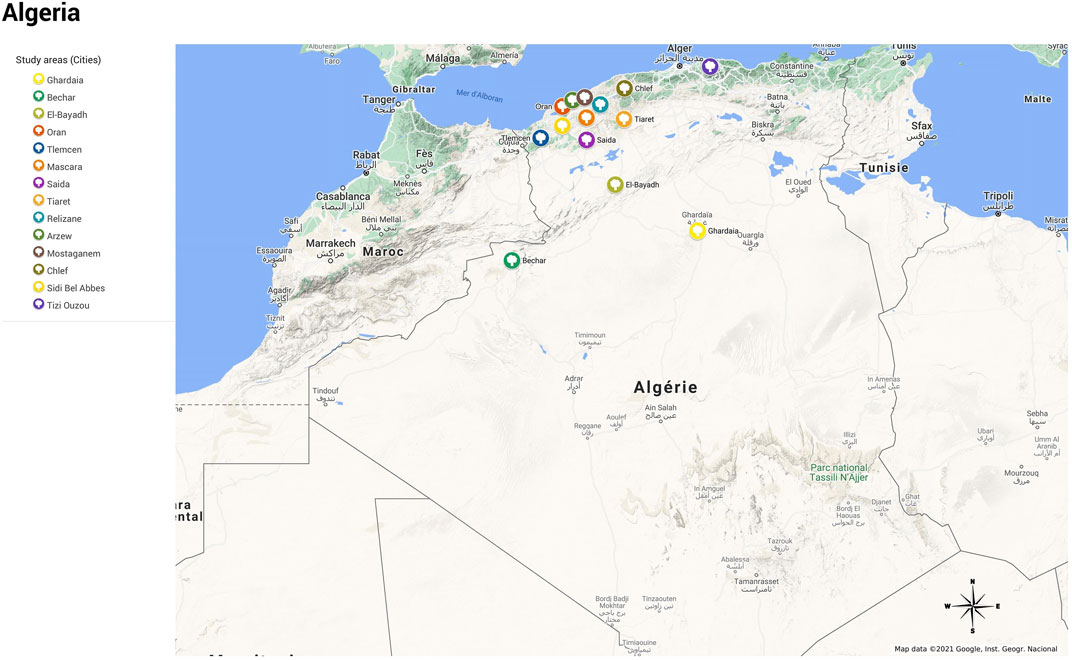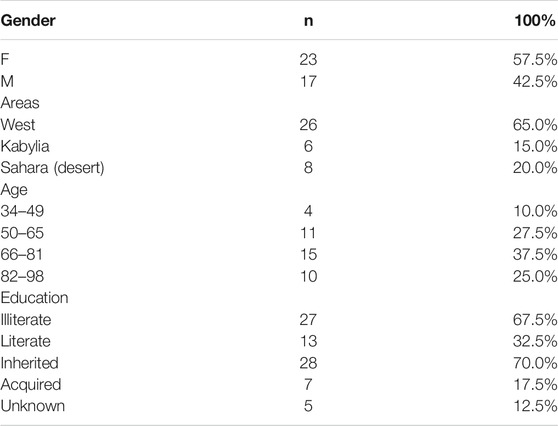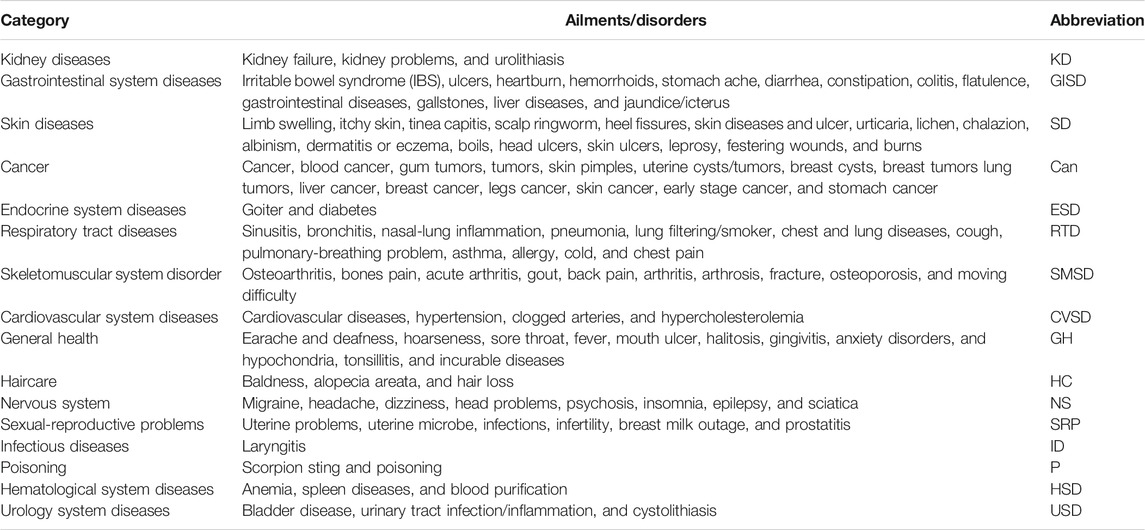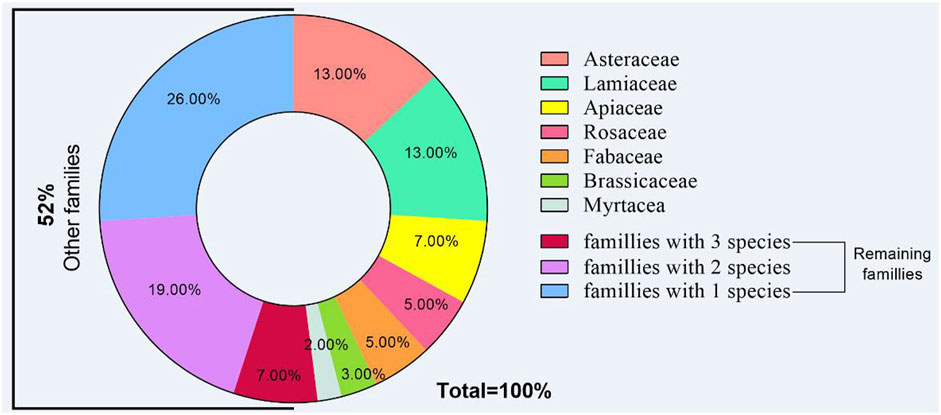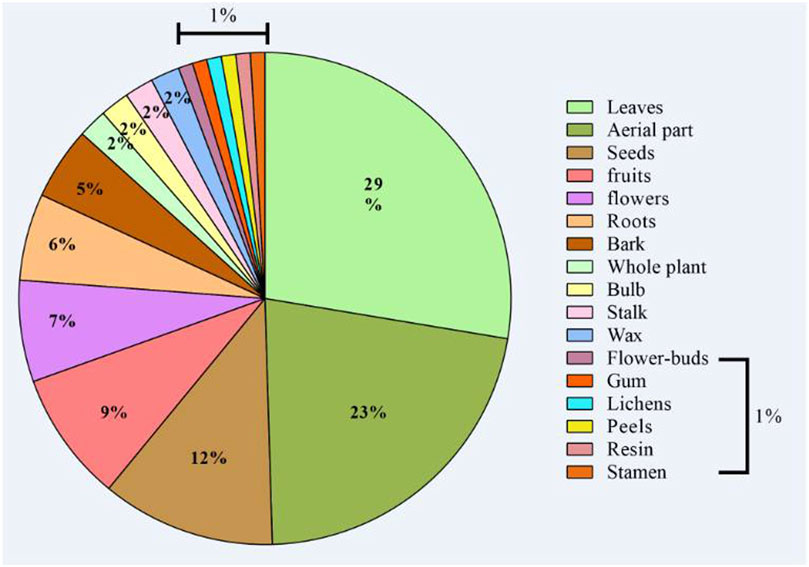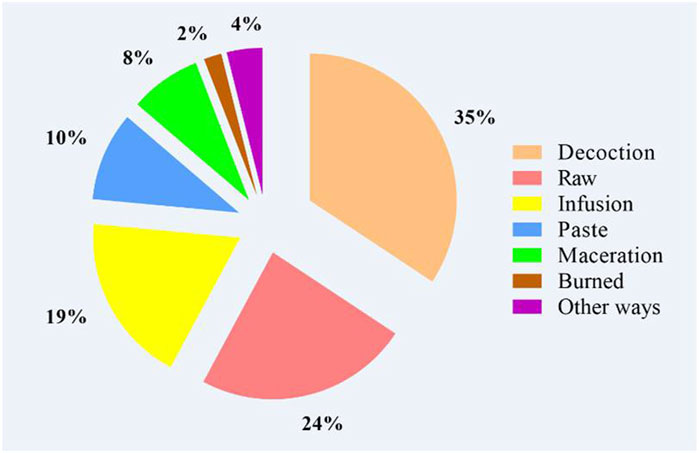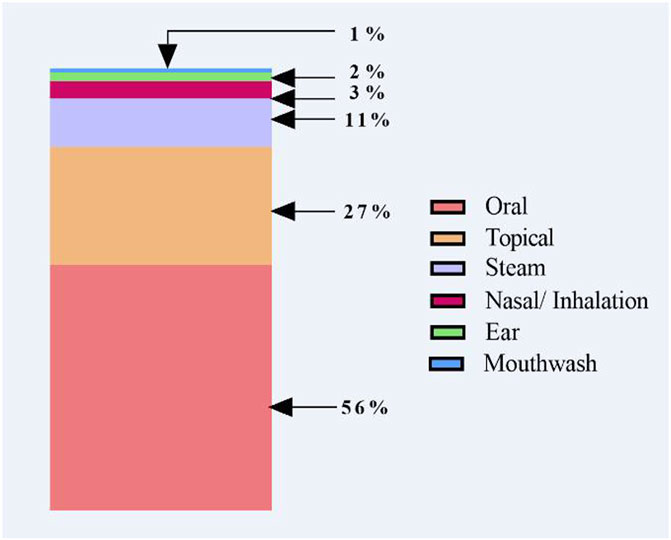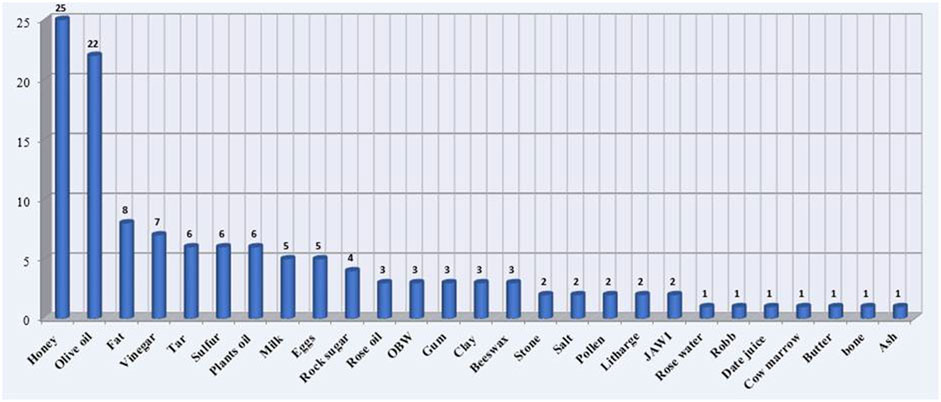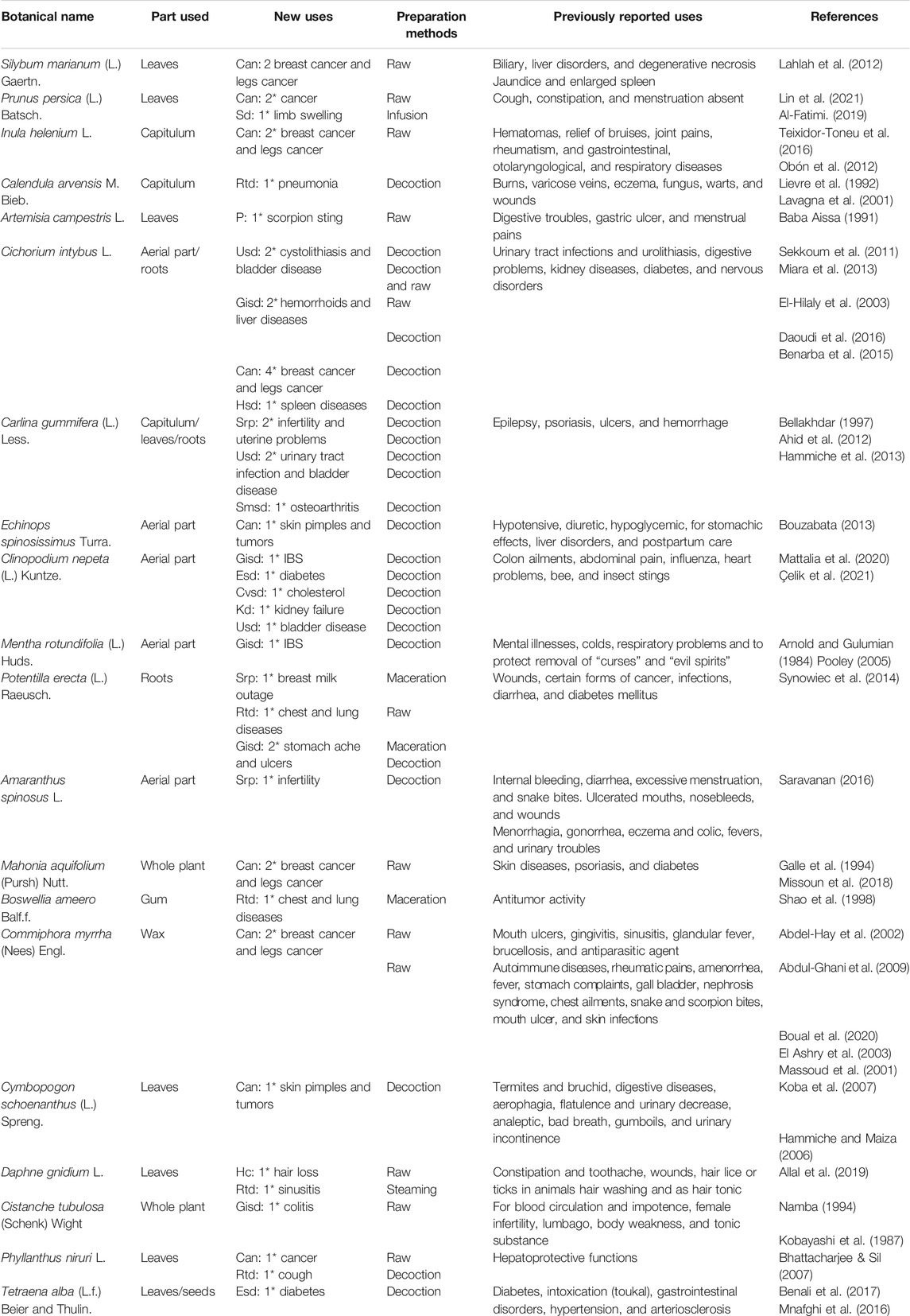- Laboratory Research on Biological Systems and Geomatics, Faculty of Nature and Life Sciences, University of Mascara, Mascara, Algeria
Traditional medicine is the cornerstone that boosts scientific research to explore new therapeutic approaches. The study aimed to assess the traditional knowledge and use of medicinal plants to treat various ailments by Algerian traditional healers. Forty traditional healers were face-to-face interviewed in three different Algerian areas (West, Kabylia, and Sahara). The data collected were analyzed using quantitative indices such as fidelity level (FL) and informant consensus factor (FIC). A total of 167 species belonging to 70 families were recorded. Lamiaceae (13%), Asteraceae (13%), Apiaceae (7%), and Rosaceae and Fabaceae (5% each) were the most cited families. The survey revealed that leaves were the most used parts of the plants (29%). Furthermore, decoction (35%), raw (24%), and infusion (19%) were the common modes for the remedies’ preparation. Here, 15% of the total species were newly reported as medicinal plants. Besides, it was reported for the first time a total of 47 new therapeutic uses for 20 known plant species. Of 17 ailments categories, cancer was presented by 44 species, showing the highest FIC of 0.46. Marrubium vulgare L., Artemisia herba-alba Asso., Zingiber officinale Roscoe., and Juniperus phoenicea L. recorded the maximum fidelity value of 100%. Therefore, our study reveals strong ethnomedicinal knowledge shared by local populations living in the three regions studied. The medicinal species with a high FL could be promising candidates for identifying new bioactive molecules.
Introduction
Medicinal plants are still considered important and promising sources of drugs to treat various diseases. Their therapeutic uses, vernacular names, modes of preparation, and routes of administration were orally transmitted to constitute a local ancestral knowledge characterizing each population or ethnic group living in a specified area. Actually, from the identification of morphine in opium in the 19th century, drug discovery is based on ethnobotanical investigations and local ethnomedicinal knowledge (Ojah, 2020). Moreover, almost 35% of drugs and about 80% of anticancer drugs used in clinical practice are plants- or natural products-derived (Calixto, 2019).
Algeria is the largest country in the Mediterranean basin, Africa, and the Arab region with a total area of almost 2.4 million km2 and 1,600 of coastline. In addition to a diversified climate, Algeria is characterized by a rich flora consisting of 4,000 taxa, 917 genera, and 131 families. Moreover, owing to its ancient history as one of the first cradles of Homo sapiens and civilization in the world, Algeria possesses an important and rich cultural diversity. Although several studies have been undertaken to document the local knowledge regarding the use of medicinal plants to treat different diseases (Benarba, 2015; Benarba et al., 2016; Chelghoum et al., 2021; Mechaala et al., 2021), the Algerian ancestral ethnomedicinal knowledge deserves more ethnobotanical investigations. On the other hand, almost all of these ethnobotanical studies covered one region and therefore the same culture and traditions. The present study was carried out in three important regions of Algeria: North-West, Kabylia (Center), and Sahara (South) to 1) record the medicinal species used for medicinal purposes and the local therapeutic practices of traditional healers and 2) document the species newly reported as medicinal plants and new uses.
Material and Methods
Description of the Study Area
The multiregional study was carried out in three regions in Algeria: North-West, Kabylia (Center), and Sahara (South) (Figure 1). The ethnobotanical investigations in the North-West were performed in five departments: Mascara (area = 5,139 Km2), Oran (area = 2,114 Km2), Mostaganem (area = 2,269 Km2), Sid Bel Abbas (area = 9,150 Km2), and Tiaret (area = 20,673 Km2) and their surrounding villages located from the Mediterranean Sea to the Moroccan borders. Although no data is available regarding the flora of each department, that of the region of Oran showed the presence of 92 taxa; out of them, 72 remain endemic (Miara et al., 2018). The ethnobotanical study carried out in Center Algeria covered one city named Tizi Ouzou and its surrounding villages covering an area of 3,568 Km2, located 100 km east of the capital (Algiers) and 30 km south of the Mediterranean Sea. Owing to its favorable climate, this region is characterized by an important vegetal diversity, including 659 species, 95 subspecies, 2 varieties, and 1 forma from 381 genera and 88 botanical families (Meddour and Sahar, 2021). The south areas included in the present study covered three of the main cities of the Algerian large desert: Ghardaïa (area = 32,256 Km2), Bechar (area = 161,400 Km2), and El Bayad (area = 71,686 Km2), characterized by important cultural, ecological, climatic, and botanical diversity (Taïbi et al., 2020; Taïbi et al., 2021). This desert wide region is characterized by sparse vegetation, grasses appearing during a short period of the year, and rare trees. According to its adaptation mode to the drought, Saharan flora can be divided into ephemeral plants, called “achebs” with a short vegetative cycle of one to four months, and perennial plants with morphological and anatomical adaptations based on an enhanced absorbent system and reduced evaporating surface. The local flora comprises 130 species belonging to 40 families (Chehma and Djebbar, 2008).
Data Collection
The ethnobotanical investigations were carried out from December 2019 to June 2020. During this period, we visited 13 cities and 19 villages in the study areas, searching for traditional healers. The data had been gathered from 40 informants; 87.5% of them were professionals, acquiring the therapeutic knowledge by the transition from generation to generation, and 12.5% were herbalists. The traditional healers were interviewed by a face-to-face interview in their homes or workplaces to fill out a questionnaire and collect the data. The responses included the demographic characteristics of healers (Table 1) and other information related to the uses of medicinal plants, such as the vernacular name, ailments treated, parts used, preparation, and administration modes. The species were given in their local names in Arabic or Amazigh.
Botanical Identification
The medicinal species mentioned by the traditional healers were collected, coded, and dried. Voucher specimens were deposited at the Herbarium of the Laboratory of Research on Biological Systems and Geomatics (LRSBG), University of Mascara, Algeria.
The taxonomic identification was performed by Professor Bachir Benarba using the standard literature (Baba Aissa, 1999; Kunkele and Lohmeyer, 2007; Trabut, 2015).
Ailment Categories
Table 2 shows more than 100 diseases recorded from the ethnobotanical investigations. All the ailments were classified into 17 categories based on the vital system/organ affected or type of damage.
Data Analysis
Ethnobotanical indices, fidelity level (FL) and informant consensus factor (FIC), were calculated to analyze the data obtained. Consensus indicators FL and FIC were used to quantify the relevance and importance of a species for a given ailment category and the agreement of its use among healers, respectively (Hoffman and Gallaher, 2007; Khan et al., 2014). FL and FIC were calculated using the following formulas (Morvin Yabesh et al., 2014):
Fidelity level: FL (%) = (Np/N)*100
Np is the number of use reports for a given species reported for a particular ailment category, and N is the total number of use reports cited for any given species.
Informant Consensus Factor: FIC = (Nur-Nt)/(Nur-1)
Nur is the number of use citations in each category, and Nt is the number of species reported in each category.
Results
Botanical Diversity, Parts Used, Modes of Preparation, and Administration
This study revealed 167 species of medicinal species used for therapeutic purposes, belonging to 70 families. Lamiaceae (13%), Asteraceae (13%), Apiaceae (7%), Rosaceae (5%), and Fabaceae (5%) were the most cited families, while the 66 remaining families (57%) had between 1 and 5 species in each (Figure 2). As shown in Figure 3, the plant parts most frequently used were leaves (29%), followed by aerial part (23%), seeds (12%), fruits (9%), and flowers (7%). Some used parts were lower than those, such as roots (6%), bark (5%), and whole plant, bulb, wax, and stalk (2% each). Besides, peels, flower buds, stamen, and gum were slightly used (1%).
Regarding the preparation methods (Figure 4), decoction (35%), raw (24%), infusion (19%), paste (10%), and maceration (8%) were the dominant methods for remedies preparation. Surprisingly, the current study recorded burning (2%) as an uncommon/novel mode used by traditional healers. In addition, the common administration route was the oral ingestion (56%) followed by external application as an ointment on the skin and compress (27%), steam (11%), or internally tract as nasal inhalation (3%), intraear (2%), and the mouthwash (1%) (Figure 5). Of the remedy’s prescription, 64% of medicinal plants were mixed with other ingredients, and 36% were taken without addition. Indeed, there were 32 species combined with one plant, 21 plants with two plants, 19 plants with three or four plants, and 14 plants with more than four plants. Furthermore, some herbal mixtures (43%, n = 74 species) were prepared by adding different adjuvants (Figure 6). These adjuvants include honey (25 use reports) followed by olive oil (22), fat (8), vinegar (7), plant oil, and sulfur and tar (6 times each).
New Reports and New Uses
By comparing the data from this study with other ethnobotanical researches carried out in Algeria and neighboring countries (Morocco, Tunisia, Mauritania, Nigeria, and Mali), we found that 11% of total species have not been previously reported as medicinal plants. Of them, 11 species were documented in Sahara, 5 in Kabylia, and 3 in West Algeria. These species are used as remedies to treat both common ailments and incurable diseases. The new reports are listed in Table 3 with their vernacular names, parts used, therapeutic uses, and modes of administration.
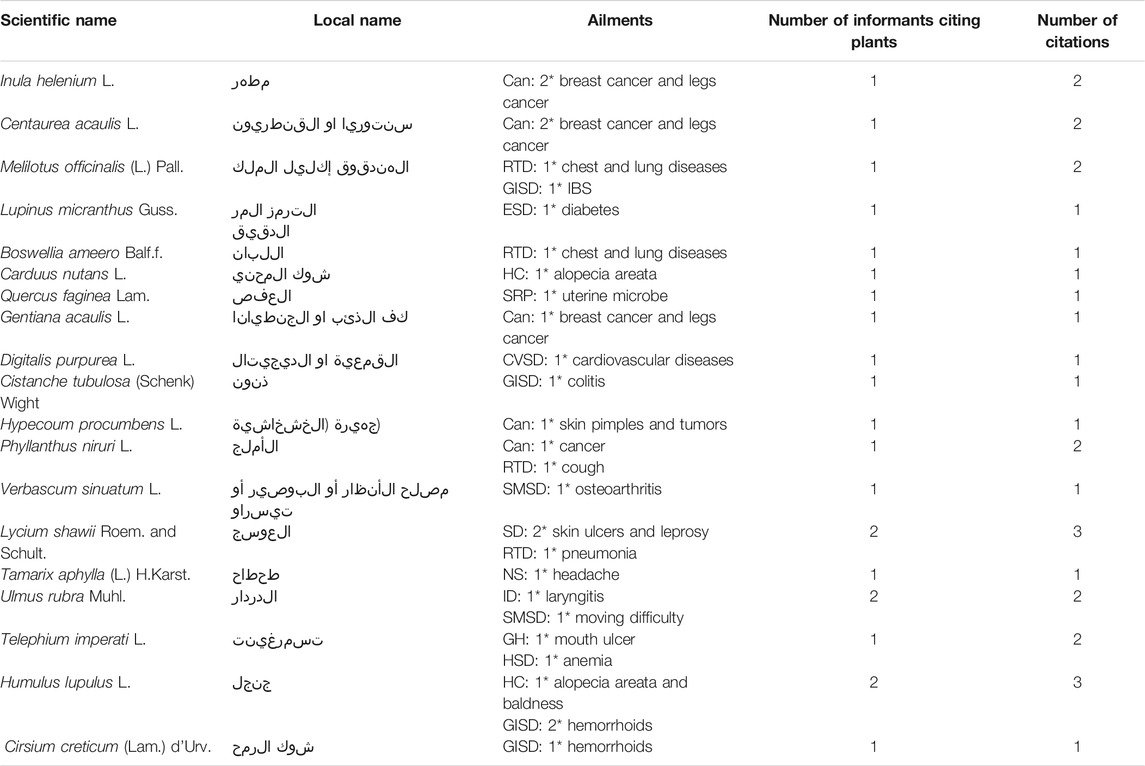
TABLE 3. New recorded medicinal plants used by traditional healers in Algeria (West-Kabylia-Sahara).
Surprisingly, 4 out of the 19 new species (Lycium shawii Roem. and Schult, Humulus lupulus L., Crataegus azarolus L., Centaurea acaulis L., and Verbascum sinuatum L.) were highly cited by the informants. V. sinuatum is used to treat gastrointestinal and respiratory tract diseases such as pneumonia, using the decoction method with oral and topical application, respectively. The plant is termed locally “Moslih el-Andar” meaning in the local dialect “tract’s fixer” relating to its effect that repairs the continuous elongated anatomical structure in the body. Similarly, the decoction of L. shawii is used to treat two ailments categories: skin diseases (skin ulcers and leprosy) and skeletomuscular system disorder (osteoarthritis). Nevertheless, these ethnomedicinal uses and their pharmacological properties have not been documented in previous studies.
Furthermore, some species were previously reported to be used for culinary purposes such as Telephium imperati L. called in local dialect as tassarghit/sarghina. The stems of the plant are usually consumed as soup’ spice for postpartum women in Algeria (Sahara and Kabylia region). As reported here, for the first time, it is newly mentioned to be used for medicinal purposes by the local healers treating mouth ulcers and anemia. Moreover, we found that decoction of Quercus faginea Lam. seeds, a popular tree in West Algeria (Alcaraz, 1989), is used to treat sexual-reproductive problems besides the fruits (raw) of Lupinus micranthus Guss., a species widely distributed in Algeria and the Mediterranean countries (Msaddak et al., 2017). On the other hand, our results showed that species such as Phyllanthus niruri L., Hypecoum procumbens L., and Gentiana acaulis L. are used to treat skin diseases and cancer via topical application. These species have not been previously reported to be used as medicinal species in the Mediterranean region.
In the present study, we found that 89% of total species have already been mentioned as medicinal plants. In fact, more than 100 species cited in this survey were reported in previous studies from different regions of Algeria. Besides, we found that, despite having similar therapeutic uses, the species had different vernacular names from a region to another. Interestingly, we report here 47 new therapeutic uses for 20 known plant species. Table 4 shows these new uses compared to those previously reported in the world.
Informant Consensus Factor and FL
Table 5 shows the 16 ailments categories arranged in descending order based on the FIC values. Cancer had the highest FIC value of 0.49 with 44 species used, such as C. colocynthis, Panax ginseng C.A. Mey., E. alata, Aquilaria malaccensis, Aristolochia longa L., and Taraxacum officinale. On the other hand, we found that sexual-reproductive problems (FIC = 0.46), gastrointestinal system diseases (FIC = 0.44), and skeletomuscular system disorders (FIC = 0.39) were recorded to have the second, third, and fourth highest FIC values, respectively. Respiratory tract diseases were ranked to be the fifth ailment group with an FIC value of 0.36.
According to their knowledge and experience, the local healers preferred some species to treat particular diseases. The highest FL values of the commonly used plants are listed in Table 6. Our results indicated that M. vulgare, A. herba-alba, Z. officinale, and J. phoenicia had the absolute FL value of 100% in several ailment categories (SRD, cancer, respiratory diseases, and GISD).
Discussion
Botanical Diversity, Parts Used, Modes of Preparation, and Administration
In the present study, we recorded 167 species belonging to 70 families with a dominance of Lamiaceae, Asteraceae, Apiaceae, Rosaceae, and Fabaceae. Our findings agreed with those we previously reported. Indeed, in Mascara (North-West Algeria), most of the medicinal species used by local healers belonged to these five families (Benarba, 2015). Similar findings were reported in Algeria (Miara et al., 2018; Taibi et al., 2020), Morocco (Barkaoui et al., 2017; Skalli et al., 2019), and Italy (Tuttolomondo et al., 2014). It has been suggested that plants belonging to these families are mainly used by local populations in Africa owing to their pharmacological effects offering a cheap therapeutic alternative (Sawadogo et al., 2012). Furthermore, leaves, aerial parts, and seeds were the most frequently used parts by local healers. Our results confirm the dominance of leaves as the most common used important plants’ part used in local phytotherapy as has been demonstrated in Algeria (Benarba, 2015; Benarba, 2016; Bouasla and Bouasla 2017; Miara et al., 2018; Taibi et al., 2020) and neighboring countries such as Mauritania (Yebouk et al., 2020), Morocco (Barkaoui et al., 2017; Skalli et al., 2019), or Italy (Leto et al., 2013). The dominance of leaves in most of the ethnobotanical studies could be explained by their ease collecting and abundance besides the fact that they are considered the site of photosynthesis and therefore of bioactive molecules.
Our results showed that the traditional healers used different preparation methods, including decoction, infusion, paste, or maceration. Decoction was found to be the preferred method. Similar results were found in previous ethnobotanical studies (Benarba, 2015; Merrouni and Elachouri, 2020). In fact, decoction and infusion were found to be the most used in the recent ethnobotanical studies in Algeria (Benarba et al., 2015; Benarba, 2016; Mechaala et al., 2021; Zatout et al., 2021) and neighboring countries such as Tunisia, Egypt, Spain, and Italy in Africa and in Europe (Giday et al., 2009; Benitez et al., 2010; Amri and Kisangau, 2012; Menale et al., 2016; Savić et al., 2019). The dominance of decoction or infusion could be explained by the disinfection potential of heating besides its extraction enhancing effects (Benarba, 2015).
We also found that oral ingestion was the most frequently used mode of administration, followed by external application, steam, and nasal inhalation. Our findings are consistent with those we previously reported in South-West Algeria (Benarba, 2016), North-West Algeria (Benarba, 2015), and Extreme-West Algeria (Tlemcen) (Zatout et al., 2021). Likewise, oral and topical applications were found to be the most frequently used administration methods used by local healers or populations in other regions in Algeria (Hammiche and Maiza, 2006; Boudjelal et al., 2013; Sarri et al., 2014; Miara et al., 2018) and neighboring countries (Mrabti et al., 2019; Fakchich and Elachouri, 2014; Benitez et al., 2010). In this same line, oral and topical administrations are frequently used in traditional medicine. The choice of administration routes is based on the pharmacological effect of each species, the therapy target, duration, and the limitation of treatment to a precise area (Sargin et al., 2015; Benarba, 2016).
The traditional healers in the study areas reported that 64% of medicinal species were mixed with other medicinal plants, whereas 43% of herbal mixtures were prepared by adding different adjuvants with a dominance of honey, olive oil, animal fat, or vinegar. In concordance with our findings, several ethnobotanical investigations carried out in Algeria demonstrated that honey was the adjuvant most frequently added to prepare medicinal herbal mixtures (Benarba, 2016; Ouelbani et al., 2016; Zatout et al., 2021). Our findings are also in perfect consistency with those reported in other regions around the world (Yabesh et al., 2014; Amri and Kisangau, 2012; Pranskuniene et al., 2016). These ingredients could enhance the plant effect, maintain the blend texture, and facilitate the treatment administration. To the best of our knowledge, some adjuvants were not previously mentioned, such as tar and litharge.
New Reports and New Uses
In the present study, 11% of the recorded 167 species have not been previously reported as medicinal plants in Algeria and neighboring countries in the Mediterranean basin. Moreover, more than 100 species reported here were previously reported to be used for therapeutic purposes in North-West (Benarba, 2015), South-West (Benarba, 2016), and North-East Algeria (Boual et al., 2020). Although each species had mostly the same therapeutic uses, for example, A. herba-alba, Punica granatum L., and Senna alexandrina Mill. were used mainly to treat gastrointestinal disorders, their vernacular names differed from one region to another such as Aquilaria malaccensis Lam. called Oud El-Rih in the West and A-ghriss in Sahara. These findings are in agreement with those reported in Algeria (Benarba, 2015; Bouasla and Bouasla, 2017), Morocco (Chaachouay et al., 2020; Merrouni and Elachouri, 2020; Yebouk et al., 2020), and other countries such as Yamen, Turkey, India, and China (Prabhu et al., 2014; Polat, 2019).
Interestingly, our findings report 47 new therapeutic uses for 20 known plant species. In the present study, we found that local populations living in the study areas used Carlina gummifera (L.) Less. to treat infertility, uterine problems, urinary tract infection, bladder disease, and osteoarthritis, whereas the plant uses previously reported included epilepsy, psoriasis, ulcers, and hemorrhage (Ahid et al., 2012; Hammiche et al., 2013). Likewise, leaves of Cymbopogon schoenanthus (L.) Spreng. were found to be used in the treatment of several types of cancer in the study areas. This use is reported for the first time since the plant was previously reported to be used mainly to treat termites and bruchid (Koba et al., 2007). Prunus persica, usually used against cough, constipation, and menstruation absent (Lin et al., 2021; Al-Fatimi., 2019), was reported by local populations to treat skin diseases.
Informant Consensus Factor and FL
Regarding the informant consensus factor, the highest FIC value was recorded for cancer (FIC = 0.49) with 44 medicinal species used. This is the first study carried out in the three regions (West, Sahara, and Kabylia) of Algeria at the same time, calculating the informant consensus factor (FIC). Our results revealed that cancer seems to be one of the most prevalent diseases in the study areas since no previous investigations had found cancer as the first ailment category according to their FIC values. In fact, cancer has become a public health issue due to an increasing incidence, with 19.3 million new cases and about 10.0 million deaths worldwide in 2020 (Ferlay et al., 2021). Likewise, cancer incidence is increasing in Algeria. Actually, Algeria has the highest incidence of gastric (6%) (Behar et al., 2021) and liver cancer (Benarba and Meddah, 2014) when compared to North African countries. Moreover, breast and thyroid cancer incidence rose significantly in the last two decades (Mehemmai et al., 2020; Halfaoui et al., 2021). This pattern may be attributed to several causes, such as a westernized lifestyle, contaminated foods, pollution, and deteriorated living conditions. Furthermore, sexual-reproductive problems, gastrointestinal system diseases, skeletomuscular system disorders, and respiratory tract diseases were recorded to have higher FIC values. In a previous study carried out in North-West Algeria, we found that gastrointestinal diseases had the highest FIC value of 0.658, followed by general health (FIC = 0.645) and respiratory diseases (0.642), while the cancer category was recorded to be the 4th highest (FIC = 0.524) (Benarba et al., 2015). Moreover, a recent study carried out in the extreme North-West of Algeria reported that the reproductive and sexual disorders FIC value were the highest score (0.98), and for the cancer category, they had an FIC value of 0.77 with 6 species (Zatout et al., 2021). In disagreement with our findings, Bouasla and Bouasla (2017) indicated that cancer (FIC = 0.25) was the least known ailment to be treated in the traditional medicine of the local population in North-East Algeria.
According to our results, M. vulgare, A. herba-alba, Z. officinale, and J. phoenicia had the absolute FL value of 100% in several ailment categories (SRD, cancer, respiratory diseases, and GISD). These findings are in agreement with those previously reported in different neighboring regions (Benarba et al., 2015; Bouasla and Bouasla, 2017; Chaachouay et al., 2020). Besides these species, Parietaria officinalis L. was found to possess an FL of 100% for kidney diseases which is consistent with findings previously reported in North-West Algeria (Benarba, 2016) and Morocco (Ammor et al., 2020). Inconsistent with our previous findings in both North-West (Benarba et al., 2015) and South-West Algeria (Benarba, 2016), T. vulgaris was the only species having the highest FL of 100% for skin diseases. This could be attributed to its antifungal and antimicrobial potentials demonstrated against the main pathogens causing skin diseases (Tadele et al., 2009; Vinciguerra et al., 2019). Recently, a facial phytocosmetic preparation from T. vulgaris was found to possess promising antiskin aging effects, as shown by enhanced adipogenesis through upregulation of PPAR-γ expression (Caverzan et al., 2021).
Conclusion
This is the first study carried out in three regions in Algeria (North, Center, and South) revealing an important botanical diversity and ethnobotanical knowledge held by local populations. The ethnobotanical survey allowed us to document 167 medicinal plants belonging to 70 families with their indigenous therapeutic uses (Table 7). Furthermore, 47 therapeutic uses for 20 known plant species were newly recorded, besides 25 species reported for the first time as medicinal plants in this study. On the other hand, A. sativum, T. foenum-graecum, Z. officinale, R. chalepensis, A. herba-alba, P. anisum, M. chamomilla, O. basilicum, and T. vulgaris had the highest UV. Moreover, some species had the absolute FL value of 100% in several ailment categories such as M. vulgare. These species could be further investigated to explore their curative proprieties and identify the possible active compounds.
Moreover, future ethnobotanical studies should adopt a multiple evidence-based approach that considers both the social-ecological-cultural context and local linguistic characteristics. In the same line, there is an urgent need for a clear strategy to include the local ethnobotanical knowledge in the conservation of biodiversity besides strong legislation aiming to protect the local medicinal species. Furthermore, establishing a unified local folk pharmacopeia based on different ethnobotanical and pharmacological investigations could be considered as one of the most important challenges in the future decade.
Data Availability Statement
The original contributions presented in the study are included in the article/Supplementary Material; further inquiries can be directed to the corresponding author.
Author Contributions
BB designed the study and prepared the questionnaire. KB carried out the ethnobotanical investigations. BB performed the identification of medicinal species. BB and KB verified the vernacular and scientific names of medicinal species. BB and KB analyzed the data and wrote the manuscript. BB revised the final version of the manuscript. All authors read and approved the manuscript.
Conflict of Interest
The authors declare that the research was conducted in the absence of any commercial or financial relationships that could be construed as a potential conflict of interest.
Publisher’s Note
All claims expressed in this article are solely those of the authors and do not necessarily represent those of their affiliated organizations or those of the publisher, the editors, and the reviewers. Any product that may be evaluated in this article or claim that may be made by its manufacturer is not guaranteed or endorsed by the publisher.
Acknowledgments
The authors would like to thank all the traditional healers for sharing their valuable knowledge.
References
Abdel-Hay, M. H., Saleh, A., El Ashry, E. S. H., Rashed, N., and Salama, O. (2002). Colorimetric Determination of Crude Powdered Myrrh, Purified Myrrh Extract, Oily Fraction, and its Different Pharmaceutical Dosage Forms. Spectrosc. Lett. 35 (2), 183–197. doi:10.1081/sl-120003804
Abdul-Ghani, R. A., Loutfy, N., and Hassan, A. (2009). Myrrh and Trematodoses in Egypt: an Overview of Safety, Efficacy and Effectiveness Profiles. Parasitol. Int. 58 (3), 210–214. doi:10.1016/j.parint.2009.04.006
Ahid, S., El Cadi, M. A., Meddah, B., and Cherrah, Y. (2012). Atractylis Gummifera: from Poisoning to the Analytic Methods. Ann. Biol. Clin. (Paris) 70 (3), 263–268. doi:10.1684/abc.2012.0699
Aissa, F. B. (1991). Medicinal Plants in Algeria. Identification, Description of Active Ingredient Properties and Traditional Use of Common Plants in Algeria.
Al-Fatimi, M. (2019). Ethnobotanical Survey of Medicinal Plants in central Abyan Governorate, Yemen. J. Ethnopharmacol 241, 111973. doi:10.1016/j.jep.2019.111973
Alami Merrouni, I., and Elachouri, M. (2020). Anticancer Medicinal Plants Used by Moroccan People: Ethnobotanical, Preclinical, Phytochemical and Clinical Evidence. J. Ethnopharmacol 266, 113435–435. doi:10.1016/j.jep.2020.113435
Alcaraz, C. (1989). Contribution à l'étude des groupements à Quercus ilex et Quercus faginea subsp. tlemcenensis, des monts de Tlemcen (Algérie). ecmed 15 (3), 15–32. doi:10.3406/ecmed.1989.1638
Allal, A., Bellifa, S., Benmansour, N., Selles, C., Semaoui, M., Hassaine, H., et al. (2019). Essential Oil and Hydrosol Extract Chemical Profile, Antioxidant and Antimicrobial Potential of Daphne Gnidium L. From Algeria. J. Essent. Oil Bearing Plants 22 (5), 1277–1288. doi:10.1080/0972060x.2019.1673832
Ammor, K., Mahjoubi, F., Bousta, D., and Chaqroune, A. (2020). Ethnopharmacological Survey of Medicinal Plants Used in the Traditional Treatment of Kidney Stones Realized in Fez-Morocco. Ethnobotany Res. Appl. 19, 1–2. doi:10.32859/era.19.50.1-12
Amri, E., and Kisangau, D. P. (2012). Ethnomedicinal Study of Plants Used in Villages Around Kimboza forest reserve in Morogoro, Tanzania. J. Ethnobiol. Ethnomed 8 (1), 1–9. doi:10.1186/1746-4269-8-1
Arnold, H. J., and Gulumian, M. (1984). Pharmacopoeia of Traditional Medicine in Venda. J. Ethnopharmacol 12 (1), 35–74. doi:10.1016/0378-8741(84)90086-2
Barkaoui, M., Katiri, A., Boubaker, H., and Msanda, F. (2017). Ethnobotanical Survey of Medicinal Plants Used in the Traditional Treatment of Diabetes in Chtouka Ait Baha and Tiznit (Western Anti-atlas), Morocco. J. Ethnopharmacol 198, 338–350. doi:10.1016/j.jep.2017.01.023
Behar, D., Boublenza, L., Chabni, N., Hassaine, H., Dahmani, B., Masdoua, N., et al. (2021). Retrospective Epidemiological Study on Stomach Cancer in a Region of Western Algeria: about 394 Cases between 2011 and 2015. J. Gastrointest. Canc 52 (2), 706–710. doi:10.1007/s12029-020-00459-z
Bellakhdar, J. (1997). Contribution à l'étude de la pharmacopée traditionnelle au Maroc: la situation actuelle, les produits, les sources du savoir (enquête ethnopharmacologique de terrain réalisée de 1969 à 1992). Metz, France: Doctoral dissertation, Université Paul Verlaine-Metz.
Benali, T., Khabbach, A., Ennabili, A., and Hammani, K. (2017). Ethnopharmacological Prospecting of Medicinal Plants from the Province of Guercif (NE of Morocco). Moroccan J. Biol. 14, 1–14.
Benarba, B., Belabid, L., Righi, K., Bekkar, A. A., Elouissi, M., Khaldi, A., et al. (2015). Ethnobotanical Study of Medicinal Plants Used by Traditional Healers in Mascara (North West of Algeria). J. Ethnopharmacol 175, 626–637. doi:10.1016/j.jep.2015.09.030
Benarba, B., and Meddah, B. (2014). Ethnobotanical Study, Antifungal Activity, Phytochemical Screening and Total Phenolic Content of Algerian Aristolochia Longa. J. Intercult Ethnopharmacol 3 (4), 150–154. doi:10.5455/jice.20140826030222
Benarba, B. (2016). Medicinal Plants Used by Traditional Healers from South-West Algeria: An Ethnobotanical Study. J. Intercult Ethnopharmacol 5 (4), 320–330. doi:10.5455/jice.20160814115725
Benarba, B. (2015). Use of Medicinal Plants by Breast Cancer Patients in Algeria. EXCLI J. 14, 1164–1166. doi:10.17179/excli2015-571
Benarba, B., Pandiella, A., and Elmallah, A. (2016). Anticancer Activity, Phytochemical Screening and Acute Toxicity Evaluation of an Aqueous Extract of Aristolochia Longa L. Int. J. Pharm. Phytopharmacological Res. 6 (1), 20–26.
Benítez, G., González-Tejero, M. R., and Molero-Mesa, J. (2010). Pharmaceutical Ethnobotany in the Western Part of Granada Province (Southern Spain): Ethnopharmacological Synthesis. J. Ethnopharmacology 129 (1), 87–105.
Bhattacharjee, R., and Sil, P. C. (2007). Protein Isolate from the Herb, Phyllanthus Niruri L. (Euphorbiaceae), Plays Hepatoprotective Role against Carbon Tetrachloride Induced Liver Damage via its Antioxidant Properties. Food Chem. Toxicol. 45 (5), 817–826. doi:10.1016/j.fct.2006.10.029
Boual, Z., Pierre, G., Kemassi, A., Mosbah, S., Benaoun, F., Delattre, C., et al. (2020). Chemical Composition and Biological Activities of Water-Soluble Polysaccharides from Commiphora Myrrha (Nees) Engl. GUM. Analele Universităţii din Oradea, Fascicula Biologie. 27 (1), 50–55.
Bouasla, A., and Bouasla, I. (2017). Ethnobotanical Survey of Medicinal Plants in Northeastern of Algeria. Phytomedicine 36, 68–81. doi:10.1016/j.phymed.2017.09.007
Boudjelal, A., Henchiri, C., Sari, M., Sarri, D., Hendel, N., Benkhaled, A., et al. (2013). Herbalists and Wild Medicinal Plants in M'Sila (North Algeria): An Ethnopharmacology Survey. J. Ethnopharmacol 148 (2), 395–402. doi:10.1016/j.jep.2013.03.082
Bouzabata, A. (2013). Traditional Treatment of High Blood Pressure and Diabetes in Souk Ahras District. J. Pharmacognosy Phytotherapy 5 (1), 12–20.
Calixto, J. B. (2019). The Role of Natural Products in Modern Drug Discovery. Acad. Bras Cienc 91 Suppl 3, e20190105. doi:10.1590/0001-3765201920190105
Caverzan, J., Mussi, L., Sufi, B., Padovani, G., Nazato, L., Camargo, F. B., et al. (2021). A New Phytocosmetic Preparation from Thymus Vulgaris Stimulates Adipogenesis and Controls Skin Aging Process: In Vitro Studies and Topical Effects in a Double‐blind Placebo‐controlled Clinical Trial. J. Cosmet. Dermatol. 20 (7), 2190–2202. doi:10.1111/jocd.13818
Çelik, G., Kılıç, G., Kanbolat, Ş., Özlem Şener, S., Karaköse, M., Yaylı, N., et al. (2021). Biological Activity, and Volatile and Phenolic Compounds from Five Lamiaceae Species. Flavour Fragrance J. 36 (2), 223–232.
Chaachouay, N., Benkhnigue, O., Khamar, H., and Zidane, L. (2020). Ethnobotanical Study of Medicinal and Aromatic Plants Used in the Treatment of Genito-Urinary Diseases in the Moroccan Rif. J. Mater. Environ. Sci. 11 (1), 15–29.
Chehma, A., and Djebbar, M. R. (2008). Les espèces médicinales spontanées du Sahara septentrional algérien: distribution spatio-temporelle et étude ethnobotanique. Revue Synthèse 17, 36–45.
Chelghoum, M., Khitri, W., Bouzid, S., and Lakermi, A. (2021). New Trends in the Use of Medicinal Plants by Algerian Diabetic Patients, Considerations of Herb-Drug Interactions. J. Ethnopharmacology 274, 113984. doi:10.1016/j.jep.2021.113984
Daoudi, A., Bammou, M., Zarkani, S., Slimani, I., Ibijbijen, J., and Nassiri, L. (2016). Étude ethnobotanique de la flore médicinale dans la commune rurale d'Aguelmouss province de Khénifra (Maroc). Phytothérapie 14 (4), 220–228. doi:10.1007/s10298-015-0953-z
El Ashry, E. S., Rashed, N., Salama, O. M., and Saleh, A. (2003). Components, Therapeutic Value and Uses of Myrrh. Pharmazie 58 (3), 163–168.
El-Hilaly, J., Hmammouchi, M., and Lyoussi, B. (2003). Ethnobotanical Studies and Economic Evaluation of Medicinal Plants in Taounate Province (Northern Morocco). J. Ethnopharmacol 86 (2-3), 149–158. doi:10.1016/s0378-8741(03)00012-6
Fakchich, J., and Elachouri, M. (2014). Ethnobotanical Survey of Medicinal Plants Used by People in Oriental Morocco to Manage Various Ailments. J. Ethnopharmacology 154 (1), 76–87.
Ferlay, J., Colombet, M., Soerjomataram, I., Parkin, D. M., Piñeros, M., Znaor, A., et al. (20211994). Cancer Statistics for the Year 2020: An overviewIn Vitro Experimental Infection of Primary Human Hepatocytes with Hepatitis B Virus. Int. J. CancerGastroenterology 149106 (43), 779664–789673. doi:10.1002/ijc.33588
Giday, M., Asfaw, Z., Woldu, Z., and Teklehaymanot, T. (2009). Medicinal Plant Knowledge of the Bench Ethnic Group of Ethiopia: an Ethnobotanical Investigation. J. Ethnobiol. Ethnomed 5, 34. doi:10.1186/1746-4269-5-34
Halfaoui, N. S., Majda, D., Nouria, D., Boulenouar, H., Behar, A., and Belhadj, M. (2021). Dietary and Female Reproductive Risk Factors for Thyroid Cancer: a Case-Control Study in Western Algeria. WCRJ 8, e1927.
Hammiche, V., and Maiza, K. (2006). Traditional Medicine in Central Sahara: Pharmacopoeia of Tassili N'ajjer. J. Ethnopharmacol 105 (3), 358–367. doi:10.1016/j.jep.2005.11.028
Hammiche, V., Merad, R., and Azzouz, M. (2013). Plantes toxiques à usage médicinal du pourtour méditerranéen. Paris: Springer.
Hoffman, B., and Gallaher, T. (2007). Importance Indices in Ethnobotany. Ethnobot. Res. App. 5, 201–218. doi:10.17348/era.5.0.201-218
Khan, I., AbdElsalam, N. M., Fouad, H., Tariq, A., Ullah, R., and Adnan, M. (2014). Application of Ethnobotanical Indices on the Use of Traditional Medicines against Common Diseases. Evid Based. Complement. Altern. Med 2014, 1–21. doi:10.1155/2014/635371
Koba, K., Poutouli, P. W., Nenonene, Y. A., Songai, M. S., Raynaud, C., and Sanda, K. (2007). Chemical Composition and Anti-termite Activity of Three Tropical Essential Oils against Termite Species Trinervitermes Geminatus (Wasmann). J. Sci. Technol. 5 (2), 39–46.
Kobayashi, H., Oguchi, H., Takizawa, N., Miyase, T., Ueno, A., Usmanghani, K., et al. (1987). New Phenylethanoid Glycosides from Cistanche Tubulosa (SCHRENK) HOOOK. F. I. Chem. Pharm. Bull. 35 (8), 3309–3314. doi:10.1248/cpb.35.3309
Lahlah, Z. F., Meziani, M., and Maza, A. (2012). Silymarin Natural Antimicrobial Agent Extracted from Silybum marianum. J. Acad. 2, 164–169.
Lavagna, S. M., Secci, D., Chimenti, P., Bonsignore, L., Ottaviani, A., and Bizzarri, B. (2001). Efficacy of Hypericum and Calendula Oils in the Epithelial Reconstruction of Surgical Wounds in Childbirth with Caesarean Section. Farmaco 56 (5-7), 451–453. doi:10.1016/s0014-827x(01)01060-6
Leto, C., Tuttolomondo, T., La Bella, S., and Licata, M. (2013). Ethnobotanical Study in the Madonie Regional Park (Central Sicily, Italy)--medicinal Use of Wild Shrub and Herbaceous Plant Species. J. Ethnopharmacol 7146 (1), 90–112. doi:10.1016/j.jep.2012.11.042
Lievre, M., Marichy, J., Baux, S., Foyatier, J. L., and Perrot, J. (1992). Controlled Study of Three Ointments for the Local Management of 2nd and 3rd Degree burns. Clin. trials meta-analysis 28 (1), 9–12.
Lin, Y., Wang, S. P., Zhang, J. Y., Zhuo, Z. Y., Li, X. R., Zhai, C. J., et al. (2021). Ethnobotanical Survey of Medicinal Plants in Gaomi, China. J. Ethnopharmacol 265, 113228. doi:10.1016/j.jep.2020.113228
Massoud, A., El Sisi, S., Salama, O., and Massoud, A. (2001). Preliminary Study of Therapeutic Efficacy of a New Fasciolicidal Drug Derived from Commiphora Molmol (Myrrh). Am. J. Trop. Med. Hyg. 65 (2), 96–99. doi:10.4269/ajtmh.2001.65.96
Mattalia, G., Sõukand, R., Corvo, P., and Pieroni, A. (2020). Blended Divergences: Local Food and Medicinal Plant Uses Among Arbëreshë, Occitans, and Autochthonous Calabrians Living in Calabria, Southern Italy. Plant Biosyst. - Int. J. Dealing all Aspects Plant Biol. 154 (5), 615–626. doi:10.1080/11263504.2019.1651786
Mechaala, S., Bouatrous, Y., and Adouane, S. (2021). Traditional Knowledge and Diversity of Wild Medicinal Plants in El Kantara's Area (Algerian Sahara Gate): An Ethnobotany Survey. Acta Ecologica Sinica. doi:10.1016/j.chnaes.2021.01.007
Meddour, R., and Sahar, O. (2021). Floristic Inventory of Djurdjura National Park, Northern Algeria: a First Checklist of its Vascular flora. Phytotaxa 490 (3), 221–238. doi:10.11646/phytotaxa.490.3.1
Mehemmai, C., Cherbal, F., Hamdi, Y., Guedioura, A., Benbrahim, W., Bakour, R., et al. (2020). Correction to: BRCA1 and BRCA2 Germline Mutation Analysis in Hereditary Breast/Ovarian Cancer Families from the Aures Region (Eastern Algeria): First Report. Pathol. Oncol. Res. 26 (2), 2009–2010. doi:10.1007/s12253-019-00625-0
Menale, B., De Castro, O., Cascone, C., and Muoio, R. (2016). Ethnobotanical Investigation on Medicinal Plants in the Vesuvio National Park (Campania, Southern Italy). J. Ethnopharmacol 192, 320–349. doi:10.1016/j.jep.2016.07.049
Miara, M. D., Ait, H. M., Dahmani, W., Negadi, M., and Djellaoui, A. (2018). Nouvelles données sur la flore endémique du sous-secteur de l'Atlas tellien Oranais "O3" (Algérie occidentale). abm 43, 63–69. doi:10.24310/abm.v43i0.4453
Miara, M. D., Hammou, M. A., and Aoul, S. H. (2013). Phytothérapie et taxonomie des plantes médicinales spontanées dans la région de Tiaret (Algérie). Phytothérapie 11 (4), 206–218. doi:10.1007/s10298-013-0789-3
Missoun, F., Bouabdelli, F., Awatif, B., Amari, N., and Djebli, N. (2018). Antidiabetic Bioactive Compounds from Plants. Mèd Tech. J. 2 (2), 199–214. doi:10.26415/2572-004x-vol2iss2p199-214
Mrabti, H. N., Jaradat, N., Kachmar, M. R., Ed-Dra, A., Ouahbi, A., Cherrah, Y., et al. (2019). Integrative Herbal Treatments of Diabetes in Beni Mellal Region of Morocco. J. Integr. Med. 17 (2), 93–99. doi:10.1016/j.joim.2019.01.001
Msaddak, A., Durán, D., Rejili, M., Mars, M., Ruiz-Argüeso, T., Imperial, J., et al. (2017). Diverse Bacteria Affiliated with the Genera Microvirga, Phyllobacterium, and Bradyrhizobium Nodulate Lupinus Micranthus Growing in Soils of Northern Tunisia. Appl. Environ. Microbiol. 83 (6), e02820–16. doi:10.1128/AEM.02820-16
Namba, H., Narahara, K., Tsuji, K., Yokoyama, Y., Murakami, M., Matsubara, T., et al. (1994). “Developmental Change in Activity of Red Cell Porphobilinogen Deaminase and its Electrophoretic Variant in the Japanese Population,” in The Encyclopedia of Wakan-Yaku (Traditionol Sino-Japanese Medicines) with Color Picture (Tokyo: Hoiku-sha), 36, 16–19. doi:10.1111/j.1442-200x.1994.tb03122.x
Obón, C., Rivera, D., Verde, A., Fajardo, J., Valdés, A., Alcaraz, F., et al. (2012). Árnica: a Multivariate Analysis of the Botany and Ethnopharmacology of a Medicinal Plant Complex in the Iberian Peninsula and the Balearic Islands. J. Ethnopharmacol 144 (1), 44–56. doi:10.1016/j.jep.2012.08.024
Ojah, E. O. (2020). Medicinal Plants: Prospective Drug Candidates against the Dreaded Coronavirus. Iberoam J. Med. 2, 314–321. doi:10.53986/ibjm.2020.0055
Ouelbani, R., Bensari, S., Mouas, T. N., and Khelifi, D. (2016). Ethnobotanical Investigations on Plants Used in Folk Medicine in the Regions of Constantine and Mila (North-East of Algeria). J. Ethnopharmacol 194, 196–218. doi:10.1016/j.jep.2016.08.016
Polat, R. (2019). Ethnobotanical Study on Medicinal Plants in Bingöl (City center) (Turkey). J. Herbal Med. 16, 100211. doi:10.1016/j.hermed.2018.01.007
Pooley, R. A. (2005). AAPM/RSNA Physics Tutorial for Residents: Fundamental Physics of MR Imaging. Radiographics 25 (4), 1087–1099. doi:10.1148/rg.254055027
Prabhu, S., Vijayakumar, S., Yabesh, J. E., Ravichandran, K., and Sakthivel, B. (2014). Documentation and Quantitative Analysis of the Local Knowledge on Medicinal Plants in Kalrayan hills of Villupuram District, Tamil Nadu, India. J. Ethnopharmacol 157, 7–20. doi:10.1016/j.jep.2014.09.014
Pranskuniene, Z., Bernatoniene, J., Simaitiene, Z., Pranskunas, A., and Mekas, T. (2016). Ethnomedicinal Uses of Honeybee Products in lithuania: the First Analysis of Archival Sources. Evidence-Based Complement. Altern. Med. 2016, 9272635. doi:10.1155/2016/9272635
Saravanan, R. (2016). Evaluation of In-Vitro and In-Vivo Anticancer Activity of Leaf Extracts of Amaranthus Spinosus Linn (Doctoral Dissertation. Chennai): College of Pharmacy Madras Medical College.
Sargin, S. A., Selvi, S., and Büyükcengiz, M. (2015). Ethnomedicinal Plants of Aydıncık District of Mersin, Turkey. J. Ethnopharmacol 174, 200–216. doi:10.1016/j.jep.2015.08.008
Sarri, M., Mouyet, F. Z., Benziane, M., and Cheriet, A. (2014). Traditional Use of Medicinal Plants in a City at Steppic Character (M’sila, Algeria). J. Pharm. Pharmacognosy Res 2 (2), 31–35.
Savić, J., Mačukanović-Jocić, M., and Jarić, S. (2019). Medical Ethnobotany on the Javor Mountain (Bosnia and Herzegovina). Eur. J Integr. Med 27, 52–64.
Sawadogo, W. R., Schumacher, M., Teiten, M. H., Dicato, M., and Diederich, M. (2012). Traditional West African Pharmacopeia, Plants and Derived Compounds for Cancer Therapy. Biochem. Pharmacol. 84 (10), 1225–1240. doi:10.1016/j.bcp.2012.07.021
Sekkoum, K., Cheriti, A., Taleb, S., Bourmita, Y., and Belboukhari, N. (2011). Traditional Phytotherapy for Urinary Diseases in Bechar District (South West of Algeria). Electron. J. Environ. Agric. Food Chem. 10 (8), 2616–2622.
Shao, Z. M., Wu, J., Shen, Z. Z., and Barsky, S. H. (1998). Genistein Exerts Multiple Suppressive Effects on Human Breast Carcinoma Cells. Cancer Res. 58 (21), 4851–4857.
Skalli, S., Hassikou, R., and Arahou, M. (2019). An Ethnobotanical Survey of Medicinal Plants Used for Diabetes Treatment in Rabat, Morocco. Heliyon 5 (53), e01421. doi:10.1016/j.heliyon.2019.e01421
Synowiec, A., Gniewosz, M. A. Ł. G. O. R. Z. A. T. A., Baczek, K., and Przybyl, J. L. (2014). Antimicrobial Effect of an Aqueous Extract of Potentilla Erecta Rhizome. Herba Pol. 60 (2). doi:10.2478/hepo-2014-0007
Tadele, A., Urga, K., Gemeda, N., Lemma, H., Melaku, D., and Mudie, K. (2009). Antimicrobial Activity of Topical Formulations Containing Thymus Vulgaris Essential Oil on Major Pathogens Causing Skin Diseases. Ethiopian Pharm. J. 26 (2), 103–110. doi:10.4314/epj.v26i2.43041
Taïbi, K., Abderrahim, L. A., Ferhat, K., Betta, S., Taïbi, F., Bouraada, F., et al. (2020). Ethnopharmacological Study of Natural Products Used for Traditional Cancer Therapy in Algeria. Saudi Pharm. J. 28 (11), 1451–1465. doi:10.1016/j.jsps.2020.09.011
Taïbi, K., Abderrahim, L. A., Helal, F., and Hadji, K. (2021). Ethnopharmacological Study of Herbal Remedies Used for the Management of Thyroid Disorders in Algeria. Saudi Pharm. J. 29 (1), 43–52.
Teixidor-Toneu, I., Martin, G. J., Ouhammou, A., Puri, R. K., and Hawkins, J. A. (2016). An Ethnomedicinal Survey of a Tashelhit-Speaking Community in the High Atlas, Morocco. J. Ethnopharmacol 188, 96–110. doi:10.1016/j.jep.2016.05.009
Tuttolomondo, T., Licata, M., Leto, C., Savo, V., Bonsangue, G., Letizia Gargano, M., et al. (2014). Ethnobotanical Investigation on Wild Medicinal Plants in the Monti Sicani Regional Park (Sicily, Italy). J. Ethnopharmacol 14153 (3), 568–586. doi:10.1016/j.jep.2014.02.032
Vinciguerra, V., Rojas, F., Tedesco, V., Giusiano, G., and Angiolella, L. (2019). Chemical Characterization and Antifungal Activity of Origanum Vulgare, Thymus Vulgaris Essential Oils and Carvacrol against Malassezia Furfur. Nat. Prod. Res. 33 (22), 3273–3277. doi:10.1080/14786419.2018.1468325
Yabesh, J. E., Prabhu, S., and Vijayakumar, S. (2014). An Ethnobotanical Study of Medicinal Plants Used by Traditional Healers in Silent valley of Kerala, India. J. Ethnopharmacol 154, 774–789. doi:10.1016/j.jep.2014.05.004
Yabesh, J. E., Prabhu, S., and Vijayakumar, S. (2014). An Ethnobotanical Study of Medicinal Plants Used by Traditional Healers in Silent valley of Kerala, India. J. Ethnopharmacol 154 (3), 774–789. doi:10.1016/j.jep.2014.05.004
Yebouk, C., Redouan, F. Z., Benítez, G., Bouhbal, M., Kadiri, M., Boumediana, A. I., et al. (2020). Ethnobotanical Study of Medicinal Plants in the Adrar Province, Mauritania. J. Ethnopharmacol 246, 112217. doi:10.1016/j.jep.2019.112217
Keywords: Algeria, medicinal plants (herbal drugs), traditional healers, phytotherapy, ethnobotany
Citation: Belhouala K and Benarba B (2021) Medicinal Plants Used by Traditional Healers in Algeria: A Multiregional Ethnobotanical Study. Front. Pharmacol. 12:760492. doi: 10.3389/fphar.2021.760492
Received: 18 August 2021; Accepted: 25 October 2021;
Published: 29 November 2021.
Edited by:
Alessandra Durazzo, Council for Agricultural Research and Economics, ItalyReviewed by:
Gizem Emre, Marmara University, TurkeyEmin Ugurlu, Bursa Technical University, Turkey
Cecilia Cordero, St. Dominic College of Asia, Philippines
Copyright © 2021 Belhouala and Benarba. This is an open-access article distributed under the terms of the Creative Commons Attribution License (CC BY). The use, distribution or reproduction in other forums is permitted, provided the original author(s) and the copyright owner(s) are credited and that the original publication in this journal is cited, in accordance with accepted academic practice. No use, distribution or reproduction is permitted which does not comply with these terms.
*Correspondence: Bachir Benarba, YmFjaGlyc2JAeWFob28uZnI=
 Khadidja Belhouala
Khadidja Belhouala Bachir Benarba
Bachir Benarba